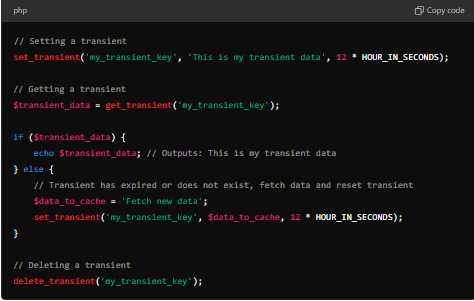In the world of web development, performance optimization is a critical aspect, especially when managing dynamic content and large datasets. WordPress, one of the most widely used content management systems (CMS), provides a powerful feature known as transients to enhance data management performance. This comprehensive guide delves into what WordPress transients are, how they work, and best practices for utilizing them to improve the performance of your WordPress sites.
What Are WordPress Transients?
Transients is a built-in caching system in WordPress that allows developers to temporarily store data with a defined expiration time. They are particularly useful for caching complex queries or API responses, reducing the need to repeatedly fetch or compute the same data, which can significantly improve site performance.
To effectively implement transients and optimize your WordPress site, consider to hire WordPress developers who have experience with caching strategies. Their expertise can help you leverage this powerful feature, ensuring your website runs smoothly and efficiently while enhancing user experience and loading times.
Key Features of WordPress Transients:
- Temporary Storage: Transients store data temporarily, typically in the database, with a defined expiration time.
- Simple API: WordPress provides a straightforward API for managing transients, making it easy for developers to implement.
- Performance Improvement: By caching data, transients reduce the number of database queries, which can lead to faster page loads and improved overall performance.
How Do WordPress Transients Work?
WordPress transients are stored in the database using the wp_options table. When you create a transient, you specify a key, a value, and an expiration time. Here’s how it works:
- Set a Transient: When you set a transient, you use the set_transient() function, which stores the data along with an expiration time.
- Get a Transient: To retrieve the stored data, you use the get_transient() function. If the transient is still valid and has not expired, it returns the stored value. If it has expired or does not exist, it returns false.
- Delete a Transient: You can remove a transient using the delete_transient() function when the data is no longer needed or when you want to force a refresh.
Example Code for Using Transients
Here’s a simple example demonstrating how to use WordPress transients:

In this example, the transient my_transient_key is set to store a string value for 12 hours. The code checks if the transient exists before deciding to fetch new data.
Benefits of Using Transients
Implementing transients in your WordPress site can yield several benefits:
1. Reduced Database Load
By caching expensive operations or queries, transients minimize the number of times the database needs to be queried. This reduction in database load can lead to faster response times and a better user experience.
2. Improved Performance
Using transients effectively can significantly improve the performance of your site, particularly in scenarios where data retrieval involves complex queries or external API calls.
3. Flexible Data Management
Transients offer a flexible way to manage temporary data. They are ideal for storing data that changes frequently but doesn’t need to be fetched on every page load.
4. Simplified Code Management
The API for transients is straightforward, making it easy for developers to implement caching without extensive overhead. This simplicity can lead to cleaner code and easier maintenance.
Best Practices for Using WordPress Transients
To get the most out of WordPress transients, consider the following best practices:
1. Choose Appropriate Expiration Times
When setting a transient, choose an expiration time that balances performance with data freshness. For example, if you are caching an API response that updates every hour, set the transient to expire after 60 minutes. This way, you ensure that your cached data is reasonably up-to-date without overwhelming the database.
2. Avoid Storing Large Data Sets
Transients are not meant for storing large datasets or files. Instead, use them for small pieces of data, such as results from database queries or API responses. Storing large objects can bloat the database and degrade performance.
3. Implement Fallback Logic
When retrieving transient data, always implement fallback logic. If the transient has expired or doesn’t exist, ensure your code has a mechanism to fetch fresh data and reset the transient.
4. Monitor and Manage Transients
Over time, transients can accumulate in the database. Regularly monitor and clean up old or unused transients to maintain database performance. You can use plugins like WP-Sweep or Transients Manager for this purpose.
5. Utilize Object Cache
For high-traffic sites or applications, consider using an object caching mechanism like Redis or Memcached. This can provide faster access to transient data compared to the default database storage, further improving performance.
When Not to Use Transients
While transients can be a powerful tool, there are scenarios where their use may not be appropriate:
- Long-Term Storage: For data that needs to persist across longer periods or isn’t expected to change frequently, consider using options or custom database tables.
- High-Volume Data: If your application requires the storage of high volumes of data, transients may not be suitable due to their temporary nature and limitations.
Conclusion
WordPress transients offer a robust solution for improving data management performance in your WordPress applications. By caching temporary data and reducing the need for repetitive database queries, transients can significantly enhance the speed and efficiency of your website. By following the best practices outlined in this guide, you can leverage the power of transients to optimize your WordPress sites effectively.
As always, regular monitoring and management of your transients will help maintain optimal performance, ensuring a seamless experience for your users. For developers looking to enhance their WordPress projects, mastering transients is a crucial step in achieving efficient data handling and improved site performance.
Additionally, collaborating with an e-commerce development company can provide valuable insights and strategies for effectively utilizing transients in your online store. Their expertise will ensure that your e-commerce platform is optimized for speed and efficiency, ultimately leading to a better shopping experience for your customers.









